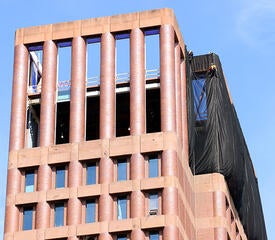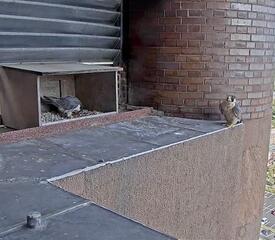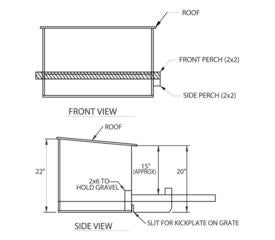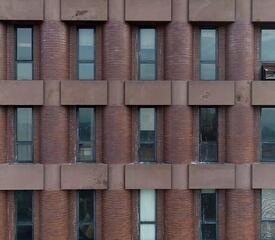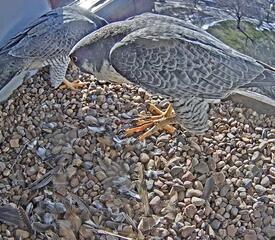We want to hear from you! Take the survey.
How do you use It’s Your Yale? How can it be improved? Answer for a chance to win Yale swag.
Preparing for falcons’ homecoming at Kline Tower
April 28, 2022
Two lines glide over the roof’s edge of Kline Tower into a cloudless sky. Tied off to the end are two harnessed contractors from Gilbane Building Company, who unravel black mesh hoarding that has enveloped the southern face of this building’s crown for months. Their rappelling exercise comes earlier in the season than expected, given the arrival of a pair of Peregrine Falcons who have been absent from campus for nearly a year. The birds have a seasonal home at the tower.
“We first installed a nesting box with Carol Hwang on the southwest corner of the building’s roof along a red stone ledge and below the old grating,” said Richard Prum, the William Robertson Coe Professor of Ornithology, Ecology, and Evolutionary Biology at the Peabody Museum of Natural History.
In winter of 2013, Professor Prum and Kristof Zyskowski, Collections Manager of Vertebrate Zoology, Mammalogy, and Ornithology at the Peabody Museum of Natural History, began to observe a pair of peregrines perching on Kline Tower. That same year, the Prum Lab at Yale obtained plans for a nesting box from The Peregrine Fund—a nonprofit focused on the conservation of threatened or endangered birds of prey worldwide—and received permission from Yale’s architectural oversight committee to place a box and install a power-over-internet line on the roof of the tower. The latter fed a camera that live-streamed video of birds considering the location.
“That first pair of peregrines ended up nesting on a ledge of East Rock, and we didn’t see falcons at Kline Tower for another six years,” Professor Prum said. A new pair of peregrines arrived at Kline Tower in April 2019 and occupied the same roof box. They engaged in courtship displays over the next few months, and by June, the female falcon laid a clutch of three eggs. Unfortunately, the eggs did not hatch, but the pair remained in residence through the fall of that year.
By the next breeding season, the Kline Tower renovation will be in full swing. “In planning for major construction at Kline Tower, our team was aware of the nesting box and collaborated with colleagues at the Prum Lab to develop a strategy that kept this area attractive for falcons to return,” said Sheri Miller, Director of Planning and Construction Management, Office of Facilities.
There was an initial discussion to move the box to another location on campus, which may have disoriented birds considering a homecoming. Professor Prum equated this option to moving someone’s house without their knowledge. “How would you find it?”
In revisiting the proposal, “the project architects presented a plan that would temporarily move the nesting box to a new location on Kline Tower, and a permanent plan for installing a box in a new location nearing the completion of construction,” Professor Prum said. “I was stunned and delighted that these planners had altered their design to provide for the birds.”
By winter 2021, the original nesting box was moved from Kline Tower’s roof and repositioned on a south-facing window overlooking what was then the recently completed Sachem’s Wood.
“Gilbane’s construction team set the bird box in a window bay on the southeastern corner of Kline Tower’s twelfth floor that could be accessed from the building interior for research,” Sheri said. “A video camera was also reinstalled to track the behavior of any peregrines that came back to campus.”
After missing a few seasons, a pair of falcons circled the tower in winter 2022. Via video feed, the peregrines were observed scraping and scribbling pebbles in the nesting box—bonding with each other through repetitive squeaks and cackles. Most likely testing the area for comfort and safety.
“We think it’s the same pair of birds from 2019 because the male is missing a claw on the middle toe of his right foot, a distinctive feature to identify them since the birds aren’t banded,” Professor Prum said.
Gilbane’s construction crew knows about the box and are excited about the birds’ activity. “They are really on board,” stated Professor Prum. “We were concerned about the birds’ return given current construction conditions and the wavy netting at the south end of Kline Tower,” Professor Prum said. “But the species seems to embrace active sites, like along highways, without issue due to disturbance.” That is when Gilbane’s team accelerated their plans to remove the netting from the tower’s south side.
Even with this level of human support, the falcons did not settle on Science Hill. “They must have chosen another nesting site this year. But we are looking forward to moving the box again to its permanent home on the roof later this summer,” Professor Prum said.
“Nonetheless, the feeling of coming into work, looking up at Kline Tower, and seeing that bird changes how I feel about coming to the office. It gets my blood pumping—and it is incredible knowing that this bird was almost completely extinct in the United States almost 50 years ago.”



